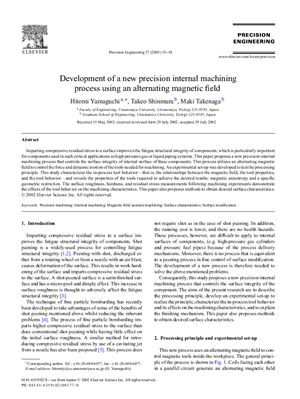Статья. Опубликована в журнале "Precision Engineering". – 2003. –
Vol. 27, Is. 1 – P. 51-58.
Статья на английском языке.
Название на русском языке: Разработка нового прецизионного процесса
внутренней обработки с использованием переменного магнитного поля.
Аннотация к статье на английском языке:
Imparting compressive residual stress to a surface improves the fatigue structural integrity of components, which is particularly important for components used in such critical applications as high-pressure gas or liquid piping systems. This paper proposes a new precision inteal machining process that controls the surface integrity of inteal surface of these components. This process utilizes an alteating magnetic field to control the force and dynamic motion of the tools needed for machining. An experimental set-upwas developed to test the processing principle. This study characterizes the in-process tool behavior—that is, the relationships between the magnetic field, the tool properties, and the tool behavior—and reveals the properties of the tools required to achieve the desired results: magnetic anisotropy and a specific geometric restriction. The surface roughness, hardness, and residual stress measurements following machining experiments demonstrate the effects of the tool behavior on the machining characteristics. This paper also proposes methods to obtain desired surface characteristics.
Imparting compressive residual stress to a surface improves the fatigue structural integrity of components, which is particularly important for components used in such critical applications as high-pressure gas or liquid piping systems. This paper proposes a new precision inteal machining process that controls the surface integrity of inteal surface of these components. This process utilizes an alteating magnetic field to control the force and dynamic motion of the tools needed for machining. An experimental set-upwas developed to test the processing principle. This study characterizes the in-process tool behavior—that is, the relationships between the magnetic field, the tool properties, and the tool behavior—and reveals the properties of the tools required to achieve the desired results: magnetic anisotropy and a specific geometric restriction. The surface roughness, hardness, and residual stress measurements following machining experiments demonstrate the effects of the tool behavior on the machining characteristics. This paper also proposes methods to obtain desired surface characteristics.

